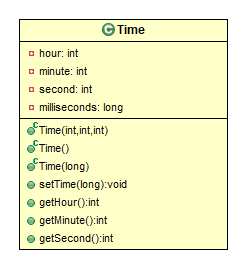(The Time class) Design a class named Time. The class contains: - The data fields hour, minute, and second that represent a time. - A no-arg constructor that creates a Time object for the current time. (The values of the data fields will represent the current time.) - A constructor that constructs a Time object with a specified elapsed time since midnight, January 1, 1970, in milliseconds. (The values of the data fields will represent this time.) - A constructor that constructs a Time object with the specified hour, minute, and second. - Three getter methods for the data fields hour, minute, and second, respectively. - A method named setTime (long elapseTime) that sets a new time for the object using the elapsed time. For example, if the elapsed time is 55555000o milliseconds, the hour is 10, the minute is 19, and the second is 10. Draw the UML diagram for the class and then implement the class. Write a test program that creates two Time objects (using new Time(), new Time (555550000), and new Time(5, 23, 55)) and displays their hour, minute, and second in the format hour:minute:second. (Hint: The first two constructors will extract the hour, minute, and second from the elapsed time. For the no-arg constructor, the current time can be obtained using System.currentTimeMillis(), as shown in LiveExample 2.7, ShowCurrentTime.java.) Class Name: Exercise10_01
(The Time class) Design a class named Time. The class contains: - The data fields hour, minute, and second that represent a time. - A no-arg constructor that creates a Time object for the current time. (The values of the data fields will represent the current time.) - A constructor that constructs a Time object with a specified elapsed time since midnight, January 1, 1970, in milliseconds. (The values of the data fields will represent this time.) - A constructor that constructs a Time object with the specified hour, minute, and second. - Three getter methods for the data fields hour, minute, and second, respectively. - A method named setTime (long elapseTime) that sets a new time for the object using the elapsed time. For example, if the elapsed time is 55555000o milliseconds, the hour is 10, the minute is 19, and the second is 10. Draw the UML diagram for the class and then implement the class. Write a test program that creates two Time objects (using new Time(), new Time (555550000), and new Time(5, 23, 55)) and displays their hour, minute, and second in the format hour:minute:second. (Hint: The first two constructors will extract the hour, minute, and second from the elapsed time. For the no-arg constructor, the current time can be obtained using System.currentTimeMillis(), as shown in LiveExample 2.7, ShowCurrentTime.java.) Class Name: Exercise10_01
Database System Concepts
7th Edition
ISBN:9780078022159
Author:Abraham Silberschatz Professor, Henry F. Korth, S. Sudarshan
Publisher:Abraham Silberschatz Professor, Henry F. Korth, S. Sudarshan
Chapter1: Introduction
Section: Chapter Questions
Problem 1PE
Related questions
Question

Transcribed Image Text:(The Time class)
Design a class named Time.
The class contains:
- The data fields hour, minute, and second that represent a time.
- A no-arg constructor that creates a Time object for the current time. (The values of the data fields
will represent the current time.)
-A constructor that constructs a Time object with a specified elapsed time since midnight, January
1, 1970, in milliseconds. (The values of the data fields will represent this time.)
-A constructor that constructs a Time object with the specified hour, minute, and second.
- Three getter methods for the data fields hour, minute, and second, respectively.
-A method named setTime (long elapseTime) that sets a new time for the object using the
elapsed time. For example, if the elapsed time is 555550000 milliseconds, the hour is 10, the
minute is 19, and the second is 10.
Draw the UML diagram for the class and then implement the class.
Write a test program that creates two Time objects (using new Time (), new Time(555550000),
and new Time(5, 23, 55)) and displays their hour, minute, and second in the format
hour:minute:second.
(Hint: The first two constructors will extract the hour, minute, and second from the elapsed time. For
the no-arg constructor, the current time can be obtained using System.currentTimeMillis(), as
shown in LiveExample 2.7, ShowCurrentTime.java.)
Class Name: Exercise10_01
Expert Solution
Introduction
Time class UML diagram :

The Time class contains the hour, minute, and second as the private data members of the class. The Time class contains the default constructor, parameterized constructor. The Time class contains the setTime that takes long as milliseconds and converts the milliseconds to the hours, minutes, and seconds.
Trending now
This is a popular solution!
Step by step
Solved in 3 steps with 2 images

Knowledge Booster
Learn more about
Need a deep-dive on the concept behind this application? Look no further. Learn more about this topic, computer-science and related others by exploring similar questions and additional content below.Recommended textbooks for you

Database System Concepts
Computer Science
ISBN:
9780078022159
Author:
Abraham Silberschatz Professor, Henry F. Korth, S. Sudarshan
Publisher:
McGraw-Hill Education

Starting Out with Python (4th Edition)
Computer Science
ISBN:
9780134444321
Author:
Tony Gaddis
Publisher:
PEARSON

Digital Fundamentals (11th Edition)
Computer Science
ISBN:
9780132737968
Author:
Thomas L. Floyd
Publisher:
PEARSON

Database System Concepts
Computer Science
ISBN:
9780078022159
Author:
Abraham Silberschatz Professor, Henry F. Korth, S. Sudarshan
Publisher:
McGraw-Hill Education

Starting Out with Python (4th Edition)
Computer Science
ISBN:
9780134444321
Author:
Tony Gaddis
Publisher:
PEARSON

Digital Fundamentals (11th Edition)
Computer Science
ISBN:
9780132737968
Author:
Thomas L. Floyd
Publisher:
PEARSON

C How to Program (8th Edition)
Computer Science
ISBN:
9780133976892
Author:
Paul J. Deitel, Harvey Deitel
Publisher:
PEARSON

Database Systems: Design, Implementation, & Manag…
Computer Science
ISBN:
9781337627900
Author:
Carlos Coronel, Steven Morris
Publisher:
Cengage Learning

Programmable Logic Controllers
Computer Science
ISBN:
9780073373843
Author:
Frank D. Petruzella
Publisher:
McGraw-Hill Education